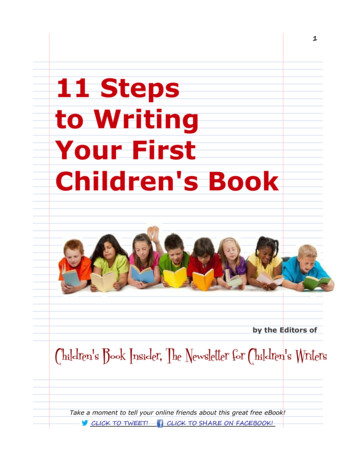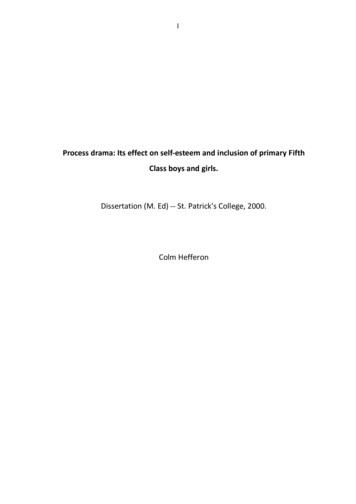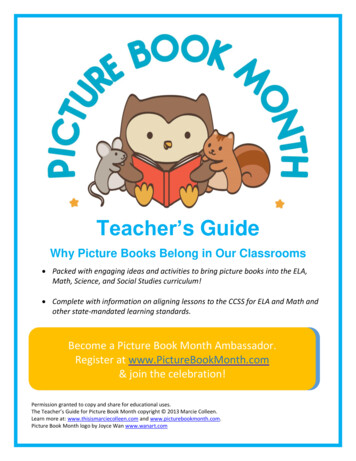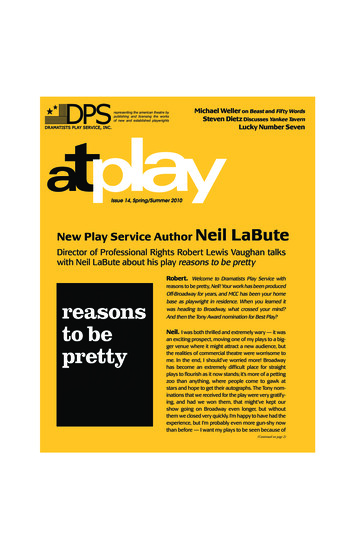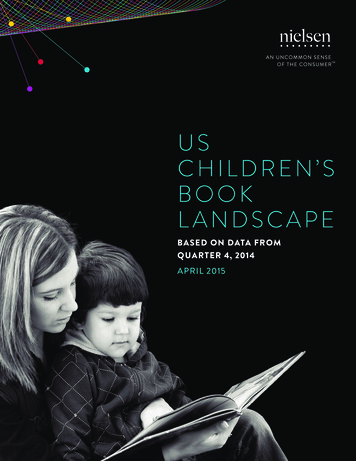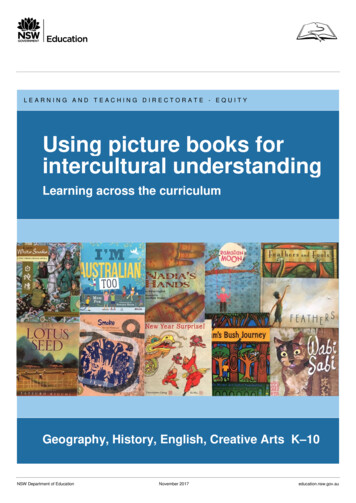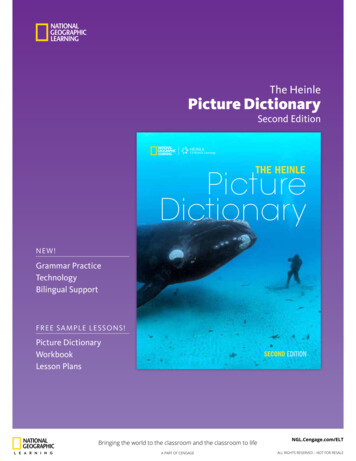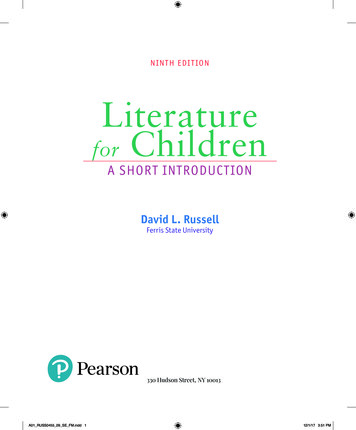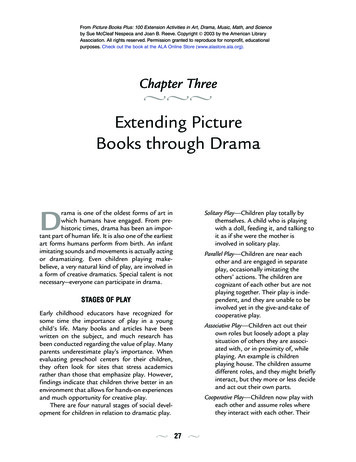
Transcription
From Picture Books Plus: 100 Extension Activities in Art, Drama, Music, Math, and Scienceby Sue McCleaf Nespeca and Joan B. Reeve. Copyright 2003 by the American LibraryAssociation. All rights reserved. Permission granted to reproduce for nonprofit, educationalpurposes. Check out the book at the ALA Online Store (www.alastore.ala.org).Chapter Three Extending PictureBooks through Dramarama is one of the oldest forms of art inwhich humans have engaged. From prehistoric times, drama has been an important part of human life. It is also one of the earliestart forms humans perform from birth. An infantimitating sounds and movements is actually actingor dramatizing. Even children playing makebelieve, a very natural kind of play, are involved ina form of creative dramatics. Special talent is notnecessary—everyone can participate in drama.DSTAGES OF PLAYEarly childhood educators have recognized forsome time the importance of play in a youngchild’s life. Many books and articles have beenwritten on the subject, and much research hasbeen conducted regarding the value of play. Manyparents underestimate play’s importance. Whenevaluating preschool centers for their children,they often look for sites that stress academicsrather than those that emphasize play. However,findings indicate that children thrive better in anenvironment that allows for hands-on experiencesand much opportunity for creative play.There are four natural stages of social development for children in relation to dramatic play. 27 Solitary Play—Children play totally bythemselves. A child who is playingwith a doll, feeding it, and talking toit as if she were the mother isinvolved in solitary play.Parallel Play—Children are near eachother and are engaged in separateplay, occasionally imitating theothers’ actions. The children arecognizant of each other but are notplaying together. Their play is independent, and they are unable to beinvolved yet in the give-and-take ofcooperative play.Associative Play—Children act out theirown roles but loosely adopt a playsituation of others they are associated with, or in proximity of, whileplaying. An example is childrenplaying house. The children assumedifferent roles, and they might brieflyinteract, but they more or less decideand act out their own parts.Cooperative Play—Children now play witheach other and assume roles wherethey interact with each other. Their
28 EXTENDING PICTURE BOOKS THROUGH DRAMAplay is dependent on others. Theyare usually acting out an entire story.Children playing school, and interacting with each other while doingthis, would be an example of cooperative play.Preschool- and kindergarten-age children areable to imitate or make sounds presented in storiesor to repeat a simple refrain. They can also perform some simple pantomime. When in first grade,they can begin to dramatize simple stories andperform very simple puppetry. By the second orthird grade, they can perform improvisation, successfully dramatize stories using simple props andcostumes, and perform puppetry or reader’stheater.BENEFITS OF USING DRAMAWITH CHILDRENChildren respond well to dramatic activities formany reasons. The following are just some of thebenefits of using drama with children.Children have the opportunity tothink creatively and develop theirimagination.They learn to think independently, forexample, “How will I act out myrole?”Drama helps children develop selfesteem.It teaches children about socialcooperation and group interaction.Children learn about group planning andhow to have a productive groupexperience (e.g., the group decideshow to perform a scene together).Children develop new vocabulary andlearn more about written languagethrough acting.Acting is a positive way to learn speechpatterns and oral expression.Drama helps children understand othersdifferent from themselves and allowsthem to put themselves “in another’sshoes.”Children have the opportunity to releasetheir emotions and use their creativeenergy.Children can become more familiar withgood literature.Drama is fun for children!CONSIDERATIONS WHEN USING DRAMAWITH CHILDRENNot all children are able to perform creative dramatics easily. Some children are self-conscious,others are very shy or timid, some are quiet andhave difficulty projecting, and others are showoffs and want to monopolize the “stage.” Thereare children who have short attention spans, andothers who are easily distracted. The adult needsto find ways to involve all children, despite theselimitations.It is also important to have plenty of space forchildren when involving them with drama. Childrenneed to be able to move freely and have room toact out their parts. However, too large of a spacecan also be problematic. A large gymnasium ormeeting room is not always ideal. Voices may echoor distort, and it is hard for young children toproject their voices in a large, wide-open space.SELECTING STORIES FOR DRAMAWhat should an adult look for when selectingstories to act out? Here are some points to consider.Make sure the story has conflict.The story should have action.Characters should have distinct personalities.There should be strong dialogue that isindependent of much description.The story should appeal to children.There should be a happy ending or onein which vice is punished and virtue
29 EXTENDING PICTURE BOOKS THROUGH DRAMAis rewarded. (Young children expectstories to have poetic justice.)Many of the folk or fairy tales are good for youngchildren to dramatize. Examples are Goldilocks andthe Three Bears, The Three Billy Goats Gruff, Cinderella, The Emperor’s New Clothes, The Little Red Hen,and The Elves and the Shoemaker.DRAMA EXPERIENCES TO USEWITH YOUNG CHILDRENFrom storytelling to reader’s theater, and frompuppetry to magic, there is a wide variety of dramatic experiences for young children. The following drama experiences are ones we selected forour various extensions.Telling Stories through MovementStories can be told through movement, forinstance, pantomime and improvisation. Danceor music can also extend the story, as indicated insome of our activities below.Pantomime is a very natural means of expression whereby children act out a character or apart of a story without words but rather throughtheir actions. No sound, props, or objects areused. However, children can use facial expressions, gestures, or other movements in their nonverbal communication.Unlike pantomime, improvisation is usuallybased on a story and unfolds as an informaldrama. Children may speak, but there is not ascript, so no lines need to be memorized. Oftenthe story is made up as children are acting it out,and they determine their own dialogue, movement, and action.Creative DramaticsThe term creative dramatics is typically used todescribe the improvised drama of preschool children. Creative dramatics are not practiced butrather spontaneous action and dialogue (if used)that is created by the participants. Nothing iswritten down, nor do children memorize anything. This is one of the earliest forms of dramathat children engage in, and it may last only a fewminutes. If you used creative dramatics with astory, the actions would be different each time.Storytelling with Propsand ParticipationWe use the term storytelling very loosely, becausetrue storytelling is done without books, where theteller uses voice and limited action to relay thestory. With very young children, however, there ismore value in sharing picture book stories, so thatthey can see the wonderful illustrations. Addingsimple props can make the story sharing muchmore dramatic, particularly for children today,who are more “visual” listeners than children inthe past. Moreover, the children can touch or playwith the prop later, and many times children willretell the story holding the prop.Choral SpeakingChoral speaking is when a group of children reador recite phrases or refrains under the direction ofthe storyteller. An advantage of choral speaking isthat a larger number of children can be engaged.There are five different ways to do choralreading—in unison, antiphonal speaking, cumulative choral speaking, solo choral speaking, andline-around choral speaking.When the whole group speaks together it iscalled unison. In antiphonal speaking, childrenare divided into two groups and each group hasits own part. In cumulative choral speaking(which we have used with Eric Carle’s Today IsMonday), the storyteller has different parts foreither individuals or groups of children, and eachgroup (or individual) is added as the story builds.Solo choral speaking allows individual participation, and line-around choral speaking is solo workwithin the group, with each child being assignedan individual line.Reader’s TheaterReader’s theater is one of the easiest forms ofdrama to use with elementary-age children. There
30 EXTENDING PICTURE BOOKS THROUGH DRAMAis no elaborate scenery, costumes and props arenot necessary (though sometimes children wearcardboard signs with their characters’ names),and, most importantly, children do not need tomemorize lines. Actors use their voices rather thanmovement. The audience uses imagination topicture the setting and the action.After selecting a piece to use for reader’stheater (“Drama Resource Books,” at the end ofthis chapter, lists several books with scripts forchildren as young as first grade), you may wish tohave the children read aloud the script first inround-robin fashion as a group, and then assignparts. The children should practice the scriptseveral times until they are familiar with theirparts; the adult can help with any pronunciationsneeded. Next, fasten each script inside a coloredfolder so that the pages are easy to turn and theaudience is not distracted by readers constantlyshifting or turning pages. For each individual role,use a bright colored marker to highlight that character’s name wherever it appears in the script sothat the child will remember when to read.Children can hold their scripts in their hands toperform, but a better method is to have a musicstand for each child, and place the script on themusic stand. This allows the children to keep theirheads up (rather than bending their heads downwhile reading the script), and their voices willbetter project out to the audience. If you do nothave music stands, tell the children to focus theireyes as often as possible on an object on the backwall (such as a clock) or to focus on two differentpeople, at different angles, near the back of theaudience. If you do not want children to stand,they can sit on stools that rotate. When they arenot involved in a particular scene, they can rotatein their chairs so their backs face the audience.The most common problem when childrenperform reader’s theater is to get them to projecttheir voices, but by practicing several times, children gain the confidence to speak more loudly.In charades, one person tries to get an audienceto guess a word or phrase by using pantomime.Although young children may need to watch anadult try it first, charades quickly becomes a dramatic activity that engages both the audience andthe performers.Puppets or MasksMagicThe variety of puppets is nearly endless: finger andhand puppets; marionettes; puppets made fromSome readers might not consider magic to be adramatic activity. However, we feel that a magicianpaper, sticks, mitts, cups, rods, and handkerchiefs; and shadow puppets, to name just a few.Masks can be made from a wide variety of materials. Puppets and masks can be elaborate or veryeasy, fun projects for kids to make. Who has notmade a spoon puppet at some time?There are excellent puppets to buy, of course.Folkmanis makes some of our favorites. The quality of these puppets is unmatched, and schools andlibraries can buy at a large discount if the puppetsare used for educational purposes. To buy just afew, go to their web site, http://www.folkmanis.com , and click on the section for buying puppetsat Internet stores. Many Internet puppet vendorssell Folkmanis puppets at this site, but we regularly buy from Act II.Puppet stages can be elaborate (we havemade our own out of conduit), but an expensivestage is not necessary. Simply turn a table on itsside and cover it with a sheet, or hang a sheet orblanket from a doorway. Or cut a hole in a largecarton or box, creating a “stage” where thepuppets can perform, or cut a hole in a smallerbox and place it on a covered table. Puppeteers sitbehind the table and have their puppets performon the “stage.”Two of our favorite puppet sites are http://www.puppeteers.org , the official site of Puppeteers of America, and http://sagecraft.com/puppetry/index.html , the Puppetry Home Page,which lists puppet organizations, festivals, information on using puppets, puppet building, performers, and more.Charades
31 EXTENDING PICTURE BOOKS THROUGH DRAMAdeliberately “acts” in a way to try to baffle theaudience. Often a costume is involved (a top hatat minimum), the magician needs to practiceseveral times, and sometimes the magician memorizes the “patter” used while performing to distractthe audience’s attention from any sleight of hand.Thus, magic is a fine fit for a drama extension.It is now time to be dazzled by some fundrama experiences!RECOMMENDATIONSPoint out the self-drawn pictures of the authorand illustrator on the back end flap of the book.Can the children find these same pictures elsewhere in the book? Mention that illustrators often“hide” personal touches in their illustrations suchas their profiles, a picture of their pet, or theirname, and so forth.ADDITIONAL EXTENSIONSDRAMA EXTENSIONSAnansi and the Magic StickEric A. Kimmel; illustrated by Janet Stevens(Holiday House)Lazy Anansi the spider discovers Hyena’s secret tokeeping his house so neat—a magic stick. Afterstealing it, Anansi creates chaos, including flooding the land when he falls asleep after asking thestick to water his plants. All turns out well as thewater forms a lake, and the animals build newhomes on the lakeshore. Illustrator Stevens usedwatercolors, watercolor crayons, acrylics, anddigital elements to create her colorful, fun illustrations.EXTENSION: MagicMATERIALS“magic” stick propPROCEDURETeach the children the first and last lines of therhyme—“Hocus-pocus, Magic Stick . . . Quick,quick, quick!”—and have them repeat these wordsat the appropriate time in the story. Also, add asimple prop—a pencil, a wooden spoon, or such—for a magic stick to wave while telling the story.Then, after consulting several easy nonfictionmagic books, teach the children several tricks sothey can perform their own magic show. Here aretwo good magic books with simple tricks—Lawrence Leyton’s My First Magic Book and Let’sMake Magic, by Jon Day.This Anansi tale has similarities to the story of“The Sorcerer’s Apprentice,” which can be foundon the video Fantasia, by Walt Disney. Or shareanother story about magic that gets out ofcontrol, such as Strega Nona, by Tomie De Paola.Bark, GeorgeJules Feiffer(HarperCollins)George, a dog, has trouble remembering how tobark, much to his mother’s chagrin. After going tothe vet, they discover that George can meow,quack, oink, and moo, because of the live animalsinside of his stomach. Once the vet removes them,George can again bark until he passes a crowd ofpeople, and then he begins saying “Hello.”Feiffer’s illustrations appear as cartoons, addingto the hilarity of this simple canine tale.EXTENSION: Storytelling with PropsMATERIALSstuffed animal dogsmall beanbag catsmall beanbag ducksmall beanbag pigsmall beanbag cowlingerie laundry bag or garbage bagposter boardcolored markersPROCEDUREAhead of time, the storyteller prepares four posterboard speech balloons as shown in figure 3.1.
32 EXTENDING PICTURE BOOKS THROUGH DRAMAbackfrontback side showsstick tapedto poster boardmesh laundry bag taped to tablewith beanbag animals: cat, duck,pig, and cowFIGURE 3.1 Materials for Bark, GeorgeEach poster board sign should have an animalsound on it for the cat, duck, pig, and cow asgiven in the book (Meow, Quack, Oink, andMoo). Next, attach a small lingerie laundry bag tothe reverse side of a table, so that children do notsee it, and place the dog on the table. Add thebeanbag animals to the bag in the order theyappear in the story. When telling the story, holdup the speech balloon signs at the appropriatetime so that the children can make the animalsound. When the vet reaches in the dog’s mouthand pulls out the animals one by one, the storyteller pretends to reach down the dog’s mouthand pulls out the animals one by one. This is agreat example of a participation story with props.dog that speaks like a human after eating vegetable soup. Then, have the children make sockpuppet dogs. For each child you will need a kneehigh sock for the body, a piece of oval-shapedposter board folded in half for the mouth, twoears, and buttons for the nose and eyes. Slide thefolded poster board inside the sock for themouth, and then have each child try on the sockto mark where the nose and eyes should be. Hotglue the buttons in place, and add the ears. Children then slide their hands inside the socks withtheir fingers on top of the folded poster boardand their thumbs on the bottom to make theirdogs “speak.” Then have the children talk likeMartha or George.RECOMMENDATIONSIf you do not have access to a large stuffed dog,you may use a smaller one and place it on a tablethat has a tablecloth or an overhanging cover tohide the bag attached to the back of the table.Work from behind the table to retrieve theanimals from the dog’s “mouth.”ADDITIONAL EXTENSIONShare the book Martha Speaks, by Susan Meddaugh, or any of her other titles about Martha, aCinderella’s RatSusan Meddaugh(Houghton Mifflin)This story’s narrator is a rat that was turned intoa coachman by Cinderella’s fairy godmother. Hissister rat accompanies him to the castle, andwhen another boy tries to kill her, a series of misunderstandings and magical spells will keep children thoroughly amazed. At the end, the coachmannarrator turns back into a rat at midnight, but his
33 EXTENDING PICTURE BOOKS THROUGH DRAMAsister remains a human. The animated art onlyadds to the wit and cleverness of this twisted Cinderella tale.EXTENSION: ImprovisationMATERIALSnonePROCEDUREBefore presenting a twisted tale, make sure thechildren are very familiar with the original version.Prior to sharing Cinderella’s Rat, have childrenretell the folktale Cinderella by acting out the partswithout a script. This is an example of improvisinga known tale. First, ask children to name the characters; then, assign parts to volunteers. Extra children can be attendees at the ball. After thisperformance, share the twisted version, Cinderella’s Rat. Talk with children about how elementsof the original tale are sustained in this newer rendition.RECOMMENDATIONSYou may want to add props when children areimprovising the original tale. Add a broom, aclear plastic shoe with sparkles, a pumpkin, andragged and dress-up clothing.ADDITIONAL EXTENSIONSThere are many other versions of the Cinderellatale from around the world. Some of our favoritesare Cendrillon, by Daniel San Souci; Mufaro’sBeautiful Daughters, by John Steptoe; The Rough-FaceGirl, by Rafe Martin; Yeh-Shen, by Ai-Ling Louie;Cinderella, by Diane Goode; and The Korean Cinderella, by Shirley Climo. Share some of these variants, and then chart the similarities and differencesbetween the tales. Do they begin and end thesame way? Are there clues that help establish theorigin of the tales and the different countries represented? Are the details related to the transformations similar? Compare the illustrations of thevarious picture books. Then have children vote ontheir favorite rendition.Duck in the TruckJez Alborough(HarperCollins)A duck driving a truck gets stuck in the muck. Afrog, a sheep in a jeep, and a goat try to help himget out and only succeed with the help of a ropeand motorboat. The duck continues on histravels, unaware that the frog, sheep, and goat arestill stuck in the muck. The playful rhyme and largeanimated illustrations add to the lively romp.EXTENSION: Telling a Story through MovementMATERIALSbrown Kraft (wrapping) paper (optional)PROCEDUREThere are four characters in this story—a duck, asheep, a frog, and a goat. Assign parts and havethe children come to the front of the room. Whiletelling the story, have each character comeforward and help push the truck, as in the story.The truck can be imaginary, but the child shouldbe told to push very hard. You can use brownKraft paper on the floor to represent the muck.Or make this story into a participatory tale byhaving children add the extra words “in the muck”both times the phrase “the truck still stuck”appears in the text. Tell children to listen carefullyfor those words, and, as the storyteller, make sureyou emphasize them. Also, at the end of the story,let them again supply the three words “in themuck” after you say the word “stuck.”RECOMMENDATIONSIf you want all the children involved, here are twoideas. Divide participants into four groups, andhave the ducks, the frogs, the sheep, and thegoats pushing the truck at the appropriate time.Or use some of the children as props, assigningsome volunteers to become the truck, one to be therock, and several to be the vegetables in the backof the truck, which fly out when the truck bumpson the rock and becomes stuck. Continue in thisway for the other characters and props, such asthe jeep, until all children have participated. If you
34 EXTENDING PICTURE BOOKS THROUGH DRAMAhave many children and need more assigned parts,add the jeep and the truck as additional roles.her scissors. This extension involves storytellingwith limited props, creative drama, and simplepantomime.ADDITIONAL EXTENSIONDo an entire program on mud! Examples are thebook Mud, by Mary Lyn Ray (found in chapter 2),and Lynn Plourde’s Pigs in the Mud in the Middle ofthe Rud (included in this chapter below).Fat CatMargaret Read MacDonald;illustrated by Julie Paschkis(August House Little Folk)This variant of a traditional Danish folktale details the antics of a very hungry cat that eats everything in his sight, including his friend the mouse.The mouse uses her scissors, which were alsoswallowed, to snip open the cat’s stomach so thatall can escape but then uses her needle and threadto sew him back up. The vivid gouache paintingsappear as folk art, fitting for this cumulative tale.EXTENSION: Acting Out a Story with PropsMATERIALSa king-sized sheetcat earssafety scissorsPROCEDUREAssign the following parts to children: cat,mouse, washerwoman, soldiers, king, and elephant. Have the cat wear ears, and drape thesheet around the child’s shoulders. Then, read thestory and have the cat “swallow” the characters asgiven in the story. The cat “swallows” them at theappropriate time by enveloping them in the sheetand hiding them from the audience so that the catappears to become fatter. The children who are“gobbled up” scrunch down under the sheet.Props can be imaginary, but we like to have themouse hold child’s scissors so that when the characters pop out from under the sheet near the endof the story, the mouse can triumphantly hold upRECOMMENDATIONSUse any color sheet for the cat. A white sheetwould be a white cat, a black sheet a black cat, oran orange or yellow sheet would keep the appearance of the illustrated cat in the story. We do notuse many props for this story, but have the catsimply swallow imaginary swords and so forth.However, you may want to add poster boardprops.ADDITIONAL EXTENSIONUse the classic children’s song “The Cat CameBack” and have children join in the refrain. It is afun song to sing with children, but the adultshould be prepared to discuss why cruelty toanimals should never occur and that there arehomes for unwanted animals. Dean Wilson performs one of our favorite versions of this song onA Child at Heart. Some verses in this song may beobjectionable because of violence, especially inlight of current circumstances in our world. Wefind the Wilson version acceptable, but be certainto preview whatever version of this song you use.Five Little Monkeys Sitting in a TreeEileen Christelow(Clarion)Five little monkeys and their mother head to theriver for a picnic supper. While Mama snoozes,the little monkeys climb a tree to tease acrocodile. One by one they disappear, to theirmother’s frantic desperation, but alas, they aresafe hiding in the tree. The traditional rhyme isaccompanied by colored pencil drawings.EXTENSION: Creative Drama with MotionsMATERIALSnone
35 EXTENDING PICTURE BOOKS THROUGH DRAMAPROCEDUREThis is a perfect story for a creative drama experience with motions. Read the story and have thechildren hold up the correct number of fingerseach time to represent the monkeys and then laythem on their opposite arms to represent the treebranch. Next, they can stick their thumbs in theirears and wiggle their fingers to tease the crocodilewhile using a high-pitched voice to mock himsaying, “Can’t catch me!” Have them extend theirarms in front as the crocodile’s jaw and snap themeach time the crocodile snaps his jaw in the story.next morning to take the kids again. The musicalscore is contained on the end pages. IllustratorSchmidt uses watercolor and gouache for the funloving illustrations.EXTENSION: Animal Movements to MusicMATERIALStape or CD playermusical recording of “Goingto the Zoo”PROCEDURERECOMMENDATIONSChristelow currently has four other books aboutthe five little monkeys (see “Bibliography ofPicture Books Used in Drama Extensions” at theend of this chapter). Several of them are veryadaptable to act out with motions or creativedrama. For example, Five Little Monkeys Jumping onthe Bed lends itself well to active motion.ADDITIONAL EXTENSIONSFor a musical version of Five Little Monkeys Jumpingon the Bed that children can act out and sing alongto, consult the Five Little Monkeys recording byKimbo. For a flannel board presentation of otherstories about monkeys and crocodiles, refer to TheFlannel Board Storytelling Book, by Judy Sierra, listedunder “Drama Resource Books” at the end of thischapter. Two different stories given in it wouldmake good extensions: “Counting Crocodiles” is atale from Indonesia, and “The Monkey and theCrocodile” is an Indian tale. Hand out the pieces ofthe story and have children bring them up and placethem on the flannel board as you tell the story.Going to the ZooTom Paxton; illustrated by Karen Lee Schmidt(Morrow)Paxton’s classic children’s song of Daddy takinghis young children to the zoo even depicts theanimals in the illustrations singing along. Dad isexhausted after the experience, but Mom dons hercircus hat and sets the alarm to get up early theSing the story first so that children are familiarwith the music and the words. Then play amusical recording of the song and have the children act out the different animal movements asgiven in the text. Children can sing the refrain andmake appropriate motions by clapping on thefirst and last line of the refrain, pointing to otherchildren on the second line, and motioning to“come along” on the third line. Two of our favorite recordings of this piece are by the song’screator, Paxton, on The Marvelous Toy and theversion by Peter, Paul, and Mary on the albumtitled Peter, Paul, and Mommy. This activity is anexample of pantomime.RECOMMENDATIONSNeither recording listed above follows the textexactly. The librarian or teacher must play thetape before presenting the book to see whichpages are different. We paper clip the pagestogether for the verses in the text that are not onthe recording so that the story flows with themusic. The Peter, Paul, and Mommy recording actually follows the book more closely than therecording by the author.ADDITIONAL EXTENSIONSTalk about the different animals you see at thezoo and discuss their habits, how they move, andwhat they eat. Fasten a large piece of mural paperor Kraft (wrapping) paper to the wall and havethe children use markers to draw different zoo
36 EXTENDING PICTURE BOOKS THROUGH DRAMAanimals as a backdrop for their performance.Then, hold a zoo party and serve peanuts (elephant), bananas (monkey), and goldfish crackers(seals).Goldilocks and the Three BearsValeri Gorbachev(North-South)The traditional fairy tale is accompanied by childappealing illustrations and modern-day detailssuch as large gold hoop earrings worn by MamaBear, flip-flops worn by Dad, and pink tennisshoes worn by Baby Bear. Goldilocks is portrayedas a small, innocent child who simply stumbledupon the homey cottage.EXTENSION: Pantomimethe porridge, shiver violently for the cold porridge,and fan their tongues vigorously for the hot.ADDITIONAL EXTENSIONThis book lends itself well to the math concepts ofnumber, size, and one-to-one correspondence.Provide props of large, medium-sized, and smallbowls, spoons, chairs, and bed coverings for thechildren to compare and sort into the order givenin the story. Reread the story and have the children use these props appropriately. Use a deep,normal, or high voice for each of the bears, andencourage the children to join in with you.Goldilocks and the Three HaresHeidi Petach(Putnam)MATERIALSnonePROCEDUREFirst, share the traditional story of the threebears. Then, put the book down, and have thechildren pantomime the actions of the lead character, Goldilocks. Tell the children what Goldilocks does, but do not have them speak; rather,they should just act out the story. Goldilockspeeks through the window, opens the door andgoes inside, smells the porridge, and tastes allthree bowls, making appropriate facial and bodyexpressions to indicate the porridge temperature.Then, as Goldilocks, they should try all threechairs and all three beds, again making appropriate movements to coincide with details of thestory. At the end, Goldilocks jumps out thewindow and runs away through the forest.RECOMMENDATIONSWatch for the children’s actions as you retell thest
through acting. Acting is a positive way to learn speech patterns and oral expression. Drama helps children understand others different from themselves and allows them to put themselves “in another’s shoes.” Children have the opportunity to release their emotions and use their creativ

